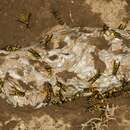en
names in breadcrumbs


Paravespula is a small subgenus of yellowjacket wasps, including some of the best-known wasp species in the world: the German wasp, Vespula germanica; the eastern yellowjacket Vespula maculifrons; the western yellowjacket Vespula pensylvanica; and the common wasp, Vespula vulgaris. It is occasionally treated as a separate genus, but this is not widely accepted.[1][2]
These particular wasps have a tendency to make underground nests with the opening usually showing from a crack in a wall or an opening in a small grass hill, which makes it quite difficult to locate to get the colony removed.[3] The wasps are aggressive and usually attack if their nests are threatened. Species in the subgenus Paravespula differ from those in the subgenus Vespula (s.str) in having larger colonies with up to thousands of individuals and several medium to large brood combs.[4]
Paravespula is a small subgenus of yellowjacket wasps, including some of the best-known wasp species in the world: the German wasp, Vespula germanica; the eastern yellowjacket Vespula maculifrons; the western yellowjacket Vespula pensylvanica; and the common wasp, Vespula vulgaris. It is occasionally treated as a separate genus, but this is not widely accepted.
These particular wasps have a tendency to make underground nests with the opening usually showing from a crack in a wall or an opening in a small grass hill, which makes it quite difficult to locate to get the colony removed. The wasps are aggressive and usually attack if their nests are threatened. Species in the subgenus Paravespula differ from those in the subgenus Vespula (s.str) in having larger colonies with up to thousands of individuals and several medium to large brood combs.
Paravespula est parvum vesparum subgenus, inter quod sunt duae species notissimae omnem per orbem terrarum endemicae: Vespula germanica et Vespula vulgaris. Hoc subgenus aliquando separatum genus habetur, sed non in universum.
Hae vespae nidos subterraneos aedificare solent, aditu usitate in fissura in vallo vel in parvo graminum colli aedificato; itaque apertura est difficile visu. Adulti saepissime ut nidum defendant infensissime adgrediuntur.
Paravespula is een relatief klein ondergeslacht binnen de onderfamilie Vespinae (veldwespen) in de familie der Vespidae (plooivleugelwespen), bestaande uit 4 soorten. Ze worden ook weleens de kortkopwespen genoemd. De groep bevat twee van de bekendste soorten de Duitse wesp (Vespula germanica) en de gewone wesp (Vespula vulgaris).
Paravespula is een relatief klein ondergeslacht binnen de onderfamilie Vespinae (veldwespen) in de familie der Vespidae (plooivleugelwespen), bestaande uit 4 soorten. Ze worden ook weleens de kortkopwespen genoemd. De groep bevat twee van de bekendste soorten de Duitse wesp (Vespula germanica) en de gewone wesp (Vespula vulgaris).